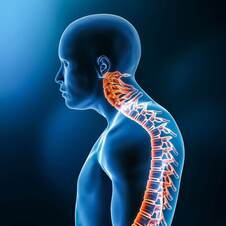|
What is it? Headache is a generic term for any pain in the cranial region. They can be caused by a variety of factors and there are many different types. A severe headache can stop you in your tracks and be severely debilitating. One kind of headache that is commonly treated by physiotherapists is cervicogenic headache or a headache that originates from the neck. What are the symptoms?
The pain of a cervicogenic headache is usually unilateral (on one side), and often described as a dull or aching pain that can be felt in the neck, head, face or even behind the eyes. It can also be accompanied by other symptoms such as neck stiffness, limited range of motion in the neck, and tenderness in the neck or scalp. How does it happen? Cervicogenic headache is an example of referred pain, where dysfunction of the structures in the neck cause pain to be felt in a different location. The most common reason for this pain to be felt are joint and muscle stiffness around the cervical spine. Tight muscles can develop trigger points that refer pain into the cranial region in a typical pattern. Headaches can also be caused by irritated nerves that originate in the spine and travel into the head. Whiplash following a trauma such as a car accident is known to be a cause of ongoing neck-related headaches. How is it diagnosed? Diagnosis of a cervicogenic headache can be difficult as it needs to be differentiated from other forms of headache such as migraine, tension headaches and sinus headaches. Your physiotherapist will perform a thorough assessment to determine the origins of your headaches. Some signs that headaches are caused by cervical dysfunction include muscle tightness, joint limitations, concurrent neck pain and poor posture. What is the treatment? Treatment for neck-related headaches is aimed at correcting any dysfunction, restoring movement and flexibility to stiff joints and muscles and addressing any postural issues.
0 Comments
For most of us, screen time and sitting go hand in hand and both are only increasing as our lives move more online. While short periods in any posture aren't harmful, a lack of movement combined with long periods spent in hunched positions can lead to spinal pain, headaches, shoulder pain and more. If you're needing to spend more time in front of a screen, here are a few tips that can help you to keep flexible and avoid pain. Set movement breaks
Posture in itself isn't always a problem. Spending long periods of time in these postures without taking breaks is the problem. When your body is so used to one position, muscles may become shorter and joints stiffer, making it harder to move out of this posture without pain and discomfort. You can break up your day by setting a timer to move and take a break every 20-30 minutes. Using these short breaks for movement is a great way to both help focus at work and keep your body more flexible. Setup your work and home environment properly Adjusting your work station or setting up a place to relax at home where to you can avoid a hunched posture can help you to reduce time in the same posture. Your physiotherapist can give you tips for how to setup your home and office environment correctly. Take stock of your time spent sitting Time in the car, time on your computer and time on the couch can all quickly add up without you realising. By accounting for the amount of time you spend sitting, you can find more ways to move. For example, if you notice that you're sitting down as soon as you get home, try swapping out watching an episode on TV to going for a walk while listening to a podcast. Ask your physio for specific stretches If you can identify the posture you spend the most time in, your physio can help you to develop a specific exercise and stretching program to counteract these positions most directly and keep you strong and flexible. Many of us spend more time at our desks than any other place in our waking hours. While the risk of injury from sitting down can seem very unlikely, spending hours in a poorly set up workspace can place a lot of pressure on your body and lead to overuse injuries or postural pain. Below are a few tips that can help you set up your workstation better. Your Chair
The height of your chair is a good place to begin. Ideally, your feet should be flat on the floor, and if you can adjust the height of the chair, your thighs should be parallel to the floor. If your chair has armrests, they should be low enough to allow your elbows to sit comfortably between 90-110 degrees of bend and rest by the side of your body. A small cushion or rolled-up towel may be added to the back of the chair to add support to the lower back to help prevent slouching. If you are unable to adjust your chair and it is too high, you can use a footrest to allow your feet to rest comfortably. Your Desk The height of your desk should be set so that your arms can rest comfortably at the keyboard and hands, wrists and forearms can sit in a neutral position, parallel to the floor. Where possible, put everything you need within easy reach and alternate days using your mouse and phone with different hands on different days (if you can do this with your non-dominant hand!). Your Screen The height of your computer should be raised so that the top of the screen is around eye level. Allowing your neck to rest in a neutral position can help to prevent neck pain and headaches. Ideally, if you can set the screen to be 20-40 inches away from your face, this will reduce strain on your eyes while reading. Some other tips Being comfortable is extremely important for productivity and focus. If you are struggling with pain, your work will often suffer. Even joint stiffness and muscle tightness can disrupt your workflow, so taking the time to adjust your workstation can save you countless hours in the long run and prevent painful overuse injuries. Taking active breaks from sitting to move and stretch can help to maintain muscle and joint health, which can be compromised from being in the same posture too long. You can set a timer or make the effort to take phone calls and video meetings standing, rather than always sitting. You can speak to your physiotherapist for more personalised advice on your workplace setup. Have you ever woken up with a stiff and painful neck that will only turn to one side? You might have been suffering from acute wry neck, a painful condition following a typical pattern of symptoms. Most wry necks are classified as one of two different types – facet (joint) or discogenic wry neck. Facetogenic Wry Neck:
Facet joints are found on either side of the spine and allow controlled rotation and side bending of the neck. An awkward or sudden movement of the neck can cause a part of the joint capsule to strain, tear or get caught in the joint, making it feel locked. The muscles around the area can also become tight and spasm, which amplifies the pain. The pain is usually sharp and can be pinpointed quite accurately to the part of the neck causing the problem, and the pain rarely travels down into the arm. It is usually possible to find a resting position where the pain goes away completely, only having pain when turning in specific directions. The good news about facetogenic wry neck is that your physiotherapist is usually able to help you ‘unlock’ the neck quite quickly with gentle mobilisations. Most of the time, a full recovery can be expected within a week. Discogenic Wry Neck: The vertebrae of the neck are separated from each other by fibrous discs, filled with a gelatinous centre. These discs provide support, flexibility and shock absorption. When placed under pressure, these discs may bulge or tear, and the resulting swelling can cause pain and muscle spasm in the surrounding area. It is important to note that in an area as sensitive as the neck, a small amount of damage can result in a large amount of pain. The development of discogenic wry neck is usually due to a combination of factors, including neck stiffness, poor posture and biomechanics than can contribute to the disc being vulnerable prior to the injury. In these cases, it can be challenging to find a comfortable position, and it is more likely for pain or tingling to travel into the arm. Treatment of discogenic wry neck is focused on reducing pain and muscle spasm with massage, taping, heat and postural education. Further treatment aims to reduce any stress that is being placed on the disc, mobilise any stiff spinal segments and correct any muscle imbalances. While the initial symptoms may settle down quite quickly, it can take up to six weeks to fully recover from discogenic wry neck. In this condition, it is also essential to address all the factors that may cause a recurrence of the issue. If you are experiencing regular neck pain that just won’t go away, it’s possible that parts of your daily routine are contributing without you realizing. Here are a few common everyday activities that might be making your neck pain worse... 1. Your sleeping position
It’s easy to underestimate the impact your sleeping position can have on you. However, spending hours in one position will undoubtedly have an effect on your body. Pillows that are too high or too flat can mean your cervical (neck) joints are sitting at the end of their range in too much flexion or extension. Similarly, sleeping on your stomach often means your thoracic (upper/mid back) spine is locked into extension and your neck is fully rotated. In simpler terms, this means your joints are under more stress than necessary. Ideal sleeping posture allows your spine to maintain its natural curves. 2. Your daily commute Many of us make sure our work stations are ergonomically set up to reduce stress and strain throughout the day. Few of us take the same consideration when it comes to driving. In fact, the set up of your car can be just as important as your work desk, particularly if you are driving more than 30 minutes every day. The correct setup in your car can mean you use less effort to drive and turn your head less often to check traffic. Ensuring that your steering wheel, seat and mirrors are set up correctly could make a difference to your posture and perhaps reduce neck pain and headaches. If you find that driving is still affecting your pain after making these changes, try catching public transport or riding a bike on alternative days if that's possible for you. 3. Your downtime Many of us unwind by watching TV or our laptops at the end of the day. Your position during this time can be something you don't really consider. However, looking up to view a screen mounted on a wall or looking down at a small screen or laptop can put pressure on the structures of the neck. Take a few minutes to consider what posture you’re sitting in before settling down to binge watch a series and see if you can either lower the height of your screen or raise it slightly so your neck can be in a more neutral position. 4. Your exercise routine Any activity that requires sustained positions or repetitive neck movements can contribute to neck pain. Cyclists can be stuck in neck extension while looking ahead and breast stroke swimmers can also have excess neck extension. Freestyle swimmers with reduced thoracic or neck rotation can have difficulty achieving rotation when breathing which can cause pain and discomfort over time. Your physiotherapist is able to identify any daily habits or activities that might be contributing to your neck pain. Come and see us for an appointment to see how we can help. |
Categories
All
|






